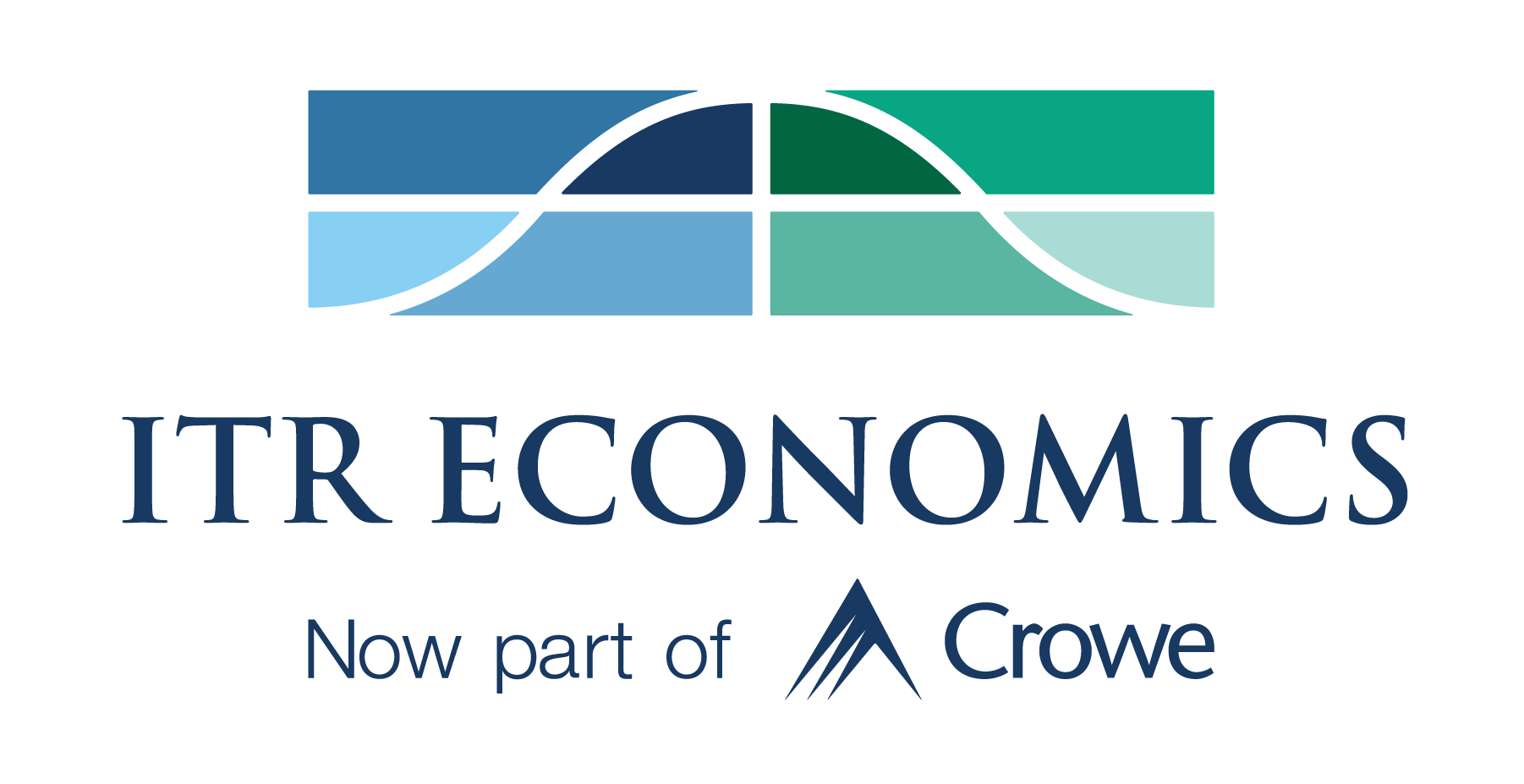- Mon - Fri: 8:30 - 5:00
- +1-603-796-2500
- ITR@itreconomics.com
January 22, 2024
- Home
- portfolio
- TrendsTalk
- January 22, 2024
with Taylor St. Germain
MANAGEMENT OBJECTIVES™ AND ECONOMIC OVERVIEW FOR 2024–2026
Tune in to the latest episode of TrendsTalk as Jackie Greene, ITR Economics Vice President of Economics, joins us to discuss our economic outlook for 2024 and beyond, including actionable advice that will benefit your business over the next few years.

MEET YOUR HOST
Taylor St. Germain
As an experienced economist, Taylor St. Germain provides consulting services for small businesses, trade associations, and Fortune 500 companies across a spectrum of industries. His dynamic personality and extensive knowledge of economic trends and their business relevance are highly valued by clients and colleagues alike.
Key Episode Takeaways
1:09 – Economic landscape for 2024, 2025, and 2026
2:38 – Actionable advice for business leaders in 2024
4:30 – Status of the labor market in 2024
6:10 – ITR Economics Producer Price Index forecast overview
8:53 – Pricing strategies with ongoing inflation rates
9:45 – Good news for some economic segments in 2024
10:17 – Market forecasts available in ITR Economics’ Trends Report™
10:54 – Aerospace forecast overview for 2024
13:04 – ITR Economics’ biggest concerns for 2024
The below transcript is a literal translation of the podcast audio that has been machine generated by Rev.
Taylor St. Germain:
Everyone. My name’s Taylor St. Germain with ITR Economics and welcome to this episode of TrendsTalk. We at ITR Economics are your unbiased and apolitical source of economic intelligence. I have a special guest on the podcast today. It is Jackie Greene. She is our vice president of economics. Thanks so much for being here, Jackie. Thanks
Jackie Greene:
For having me, Taylor. It’s great to see you.
Taylor St. Germain:
Great. And for all the listeners today, we’ll be focusing a lot on what we call our management objectives, and so the goal of the podcast today in terms of a conversation between Jackie and I, is not just to discuss the economic landscape as we look at 2024, 2025 and 2026, but how to capitalize on the economic cycle as we look at the forecast that we’ve laid out for you on previous podcasts and through some of our subscriptions content that I know many of our viewers have access to.
So Jackie, I wanted to start off, I guess sharing with our listeners the economic landscape. I’ve detailed this 2024 mild recession followed by growth in 2025 and 2026. Is that still on track? What do you see in terms of the next three years when we look at this big US economy?
Jackie Greene:
100% still on track, just setting the stage and like you said, you’ve detailed it. Just a reminder to everyone that 2024 could slide a little into early 2025 on the low timing just based on if the Fed’s inverted yield curve continues on along that way, just one those things to watch for. And that could mean that 2025 isn’t quite as robust as a whole, but it’ll still be on the upward trajectory and some growth in ’26. So growth in ’25 either way, but the amount is still a little in flux.
Taylor St. Germain:
And we’re of course here to keep you all updated as this forecast develops throughout 2024. Now with this mild downturn that some data sets are already experiencing, some clients are already experiencing in 2024, even with this mild downturn, we’re talking a lot about investing through 2024. And I think that goes to the nature of how mild this recession really is compared to previous recessions, but also it circles back to capitalizing on the economic cycle to be prepared for growth in the future.
So when we talk about investing through this downturn internally, what are some of those, what we call management objectives for our listeners that you’re focused on in 2024, Jackie?
Jackie Greene:
One of the ones I’m most focused on is how can you be efficient and what do you need for human capital, right? We know that that’s a very expensive part of the business for everyone and we know that if 2024 is a down year, most people the go-to in the playbook is cutting employees so that you’re saving it on expenses, but you’ve really got to think where you’re going to be in 2025.
How long is your ramp up time for training or is now a great time to bring on ways to automate the process while things are a little slower for you so that you’re ahead of that upturn in 2025 and you don’t need more people for 2025? You’ve really got to know where your business is going to go and do out the cost of what’s going to be most efficient for you and thinking long term human capital is always going to get more expensive.
Taylor St. Germain:
It seems counterintuitive, right? Where businesses are pulling back in 2024, we’re suggesting to be ramping up and I think that really shows the power of our methodology because we’re always thinking a business cycle ahead. And if you adopt that approach, I think businesses will find themselves in a great position in ’25 and ’26 if they’re using some of this slower period of activity to be preparing for those growth years.
Jackie Greene:
I agree, and it’s hard. It’s definitely one of those things that you’re going to have to convince people that this is the right move to do. You’re going to need to be able to show them with confidence what the forecast is going to be so that they can take that step because it’s not always the easy thing to spend money when you see revenues are going down. So it’s going to take a little bit more of that gusto in leading with confidence through this time period.
Taylor St. Germain:
Certainly, and you mentioned the labor market or the cost of human capital, and we don’t see the labor market loosening up much at all if at all, right, in 2024?
Jackie Greene:
For the most part, yes. You might see a little pockets here and there and you might see some of the pressure off, but generally your highly skilled people are still going to be in high demand because while there are going to be some markets that are going down, many of them go down, that top tier of labor is really going to be held on too tightly.
You might see more flux in more of the C players out there. You’re still going to be looking for that top tier and you’ve got to make sure you’re holding your top tier also. We’re not seeing the great resignation wave anymore, so that’s a positive, but it doesn’t mean that you’re immune from some changes if someone gives them a better offer. So you’ve still got to be very careful about how you keep your team engaged and how you keep them wanting to be there. So it’s not just constantly paying more, but what are you doing for your culture to keep them there?
Taylor St. Germain:
Yeah. I know when I’ve been asked the question around layoffs in 2024, I often said, well, if you look at the forecast, you’re going to need those people in ’25 and ’26.
Jackie Greene:
Yes. One thing, sorry, just sometimes, and I’ve seen this with other people is they know they’re going to need the people, but they use the term layoff now as a way to get rid of some of the C level players that they were wanting to clear off the bench anyways, and this is a good cover move for it sometimes. It’s a strategy. I’m personally a transparency sort of person, so that’s not the strategy I go with, but I have seen others employ it.
Taylor St. Germain:
Sure. Not just in 2024 do we have that dip in the economy, but we also have a forecast that’s gotten a lot of attention from the clients I work with at least as of late, which is our PPI forecast, our producer price index. That is negative for 2024. I’m quoting the annual growth rate, so year over year comparing 2024 to 2023, we have a negative about two, I think it’s 2.5%, 2.7% in that forecast.
And for those of you that’s subscribed to the trends report, you can see that in there, but with a negative PPI forecast, that often means raising prices will be challenging in 2024. It doesn’t mean it’s impossible, but it often means that will be quite a challenging conversation. Would you agree?
Jackie Greene:
I do. And that’s why in those, if you’re going to try and raise prices, you’re going to really have to point to why, and it’s because like you mentioned, the PPI is one number, so you’re going to have to look at the components, what really is more specific to you, and maybe that’s where you can have some more leverage for raising your prices if the overall PPI is down, but your actual commodities aren’t seeing that same level of decline.
Taylor St. Germain:
And even with some of the material costs or finished goods being down, we still have employment as we’ve been talking about, that’ll probably be up, I shouldn’t say probably that will very likely be up as we look at how tight this labor market is here today. So there might still be some price increases, but I’m assuming they’ll be more focused on the cost of labor side maybe than the cost of material side.
Jackie Greene:
That’s where I think a lot of it’s going to be stemming from. Wage growth is still on the rise to your point, but expect that pressure to be less in 2024 because we are going to see the consumer price index in a disinflation trend. So that’s that slower rate of growth. It’s still rising, but nowhere near where it was. So that pressure on wages is easing, but it hasn’t gone away by any means.
Taylor St. Germain:
I think it comes back to avoid linear thinking, especially when we look at the producer price index. When we look at the CPI even, it’s not ’21, ’22 when everyone’s raising prices again. It’ll be much more challenging. And I know we’ve been talking with a lot of our clients about with the strategy teams and sales teams we work with and be prepared for these conversations and have some ammunition ready to go because it’ll be more challenging to get these through, these increases through in 2024.
Jackie Greene:
Certainly. That’s why as one of our management objectives is don’t compete on price alone. Know your competitive advantages so that you have something else to point to. Yes, our prices are higher, but we get to you faster than anyone else, or we get to you more reliably than anyone else. Make sure you are strong in those competitive advantages so you aren’t competing on price alone. That’s going to be your key move for 2024.
Taylor St. Germain:
Even for 2024 because I think in ’25 and ’26 we have inflation ramping back up, and I imagine that’ll be a time where most are raising prices due to the finished good side once again.
Jackie Greene:
That would be my expectation too. It’s a little hard not to raise prices when all the input prices are going up.
Taylor St. Germain:
That’s it. I wanted to, we’ve been talking about challenges a lot so far, I wanted to highlight some of the good news for 2024, and there are markets that will grow in 2024. I think of the residential housing market recovering. Of course, we have to watch the Fed very closely and what they do with lowering those rates, but also some commercial construction segments likely to perform quite well. Any segments in particular you’d like to call out for 2024 in terms of the good news segments?
Jackie Greene:
I would also call out oil and gas. I think that’s one that we’re expecting to rise, so I’m excited about that one. One that’s not quite as a good news, but it’s on the verge of being good news is food production. It’s still got a little bit more decline left in 2024, but it will start turning the corner earlier than some of the other markets out there. So that’s one that’s on the getting to good news side of things.
Taylor St. Germaine:
And again, for everyone that subscribes to our trends report, you can see our at a glance dashboards and those will show you many of our market expectations for 2024. And it’s not just looking for the ones that have positive growth rates, but maybe even some sense looking for those with some less negative growth rates.
I’ve pointed out defense with some of our clients as of late, and they seem to be doing quite well in sectors like that. So I think it goes back to our look for some of those countercyclical markets or look for some of the markets that will experience decline that’s less severe than others.
Jackie Greene:
One I want to hit on real fast is while we have in the ITR trends report that aerospace is going to be doing well in 2024, there’s been some recent news that hasn’t been factored into that forecast yet. So I want everyone who’s listening and reading the trends report to just be aware that’s one of those things we’re watching. It’s a developing case.
We may end up adjusting that forecast. It’s still early, but the forecast is built on market demand being there. So this is one of those times where something else is getting in the way of market demand if we are changing that forecast. But we’re also waiting to see if supply comes in from elsewhere because this is US production in this case, and there’s other places that do produce.
Taylor St. Germain:
Yeah, that’s deemed to always be the bright light when I looked at that manufacturing dashboard and trends report, it was aircraft, and I think that’s because aircraft generally speaking has lag time, right?
Jackie Greene:
It can have some lag time, and in this case, it really actually was lagged from so much holdover from Covid time period that it doesn’t always have the lag, but this was a pretty substantial lag because of Covid and then everyone came back to air travel with such, I want to get out of my house approach to it that the airlines were like, okay, we are going to get going again.
Another big factor for airfare, airlines actually is really oil prices too, because the higher the oil prices go, the more efficient they need their planes to be, and that can really spur on some new investments also. So watching where those continue to go might impact that oil, excuse me, that aerospace outlook.
Taylor St. Germain:
Yeah, oil, at least in my short seven-year career as an economist, oil seemed to always be the problem during these downturns, and now all of a sudden oil’s remaining at a level that’s very profitable for new drilling, and it seems like that’s really what’s boosting oil and gas right now.
Jackie Greene:
It is. Normally you would see more of a decline in where the oil is going because we are in that slower growth period. So it is really quite a boost right now.
Taylor St. Germain:
Yeah, some political factors at play there too, from around the world as always with oil, and I know we’ve talked about that on the podcast in the past. Jackie, last question for you, biggest concern for 2024 as it relates to further downside or upside, something that keeps you up at night?
Jackie Greene:
My biggest concern is the Fed’s interest rate. If they make some extreme adjustments, what it would mean for the housing market, that would be my biggest concern. Not just because of the housing market, but because of the ripple impact that would have on plenty of other things and a lot of other investments that businesses would be making too. So the Fed’s involvement with interest rates is probably my biggest concern that keeps me up at night. But now I’m curious, what’s yours?
Taylor St. Germain:
I think I’ll stick with oil and gas and say a major change in OPEC’s thinking. I think if OPEC significantly increases production in the market and that price drops … Every OPEC meeting keeps me up at night. So that’s what I’ll be watching closely.
Jackie Greene:
All right. Every Fed meeting keeps me up at night, so we’ll take turns.
Taylor St. Germain:
Hopefully they’re not offsetting nights. Well, Jackie, thank you so much. I really appreciate you taking the time to come on here on TrendsTalk here today. For those of you that have not subscribed to TrendsTalk, please subscribe to TrendsTalk wherever you listen to your favorite podcast. We have a lot more exciting guests and content coming your way throughout 2024. So I just want to thank Jackie again and we will see you all on the next episode of TrendsTalk with ITR Economics. Thanks so much for tuning in.




